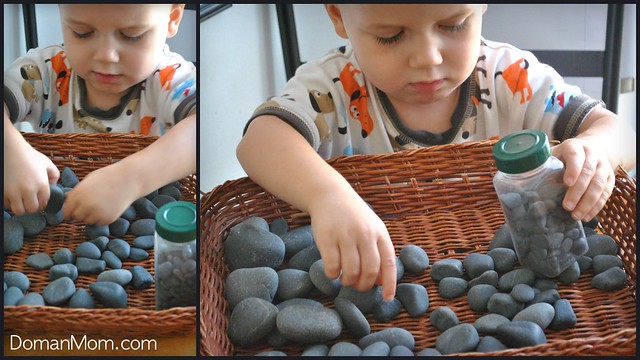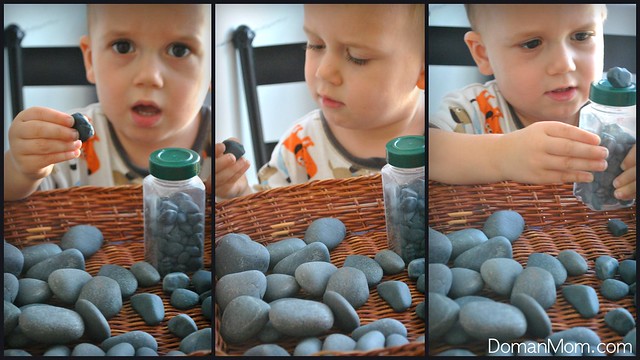
A few months ago we were visiting Lake Michigan and, while relaxing in the sand at the water's edge, I couldn't help being fascinated with all of the rocks. Their variety of size, color, shape.
My mind, of course, couldn't stop wondering what educational purpose I could use them for (it's a curse).

I ended up collecting a wide variety of black ones (once dry, they ended up being dark grey) to make a natural playset with. Their size varies, with some being as big as a golf ball to some being as small as an apple seed. I didn't count them, but my guess is there are about 80 rocks in total. Here are some of my ideas for utilizing this collection:
• Classifying & Sorting. They can be classified and sorted into piles or groups based on size, shape, or other unique characteristics.
• Ordering some or all of them from biggest to smallest, longest to shortest, heaviest to lightest, etc.
• Using ordinal words (first, second, third / next, last).
• Vocabulary development with size words, such as big, large, medium, small, tiny, and so on (there is a quite a substantial variety in size so it opens up the door to using words other than simply "big" and "little").
• Counting and Arithmetic. They can be used to count or do addition and subtraction with.
• Comparison. Discussing mathematical and other differeneces, such as "There are ten more medium rocks than there are large rocks", or "There are fewer triangular shaped rocks than there are oval shaped rocks".
• Shapes & Describing Features. Lots of vocabulary development opportunities for describing the uneven and unique shapes of the individual rocks (curved or pointed sides, number of surfaces, shapes of different areas, and so on), and how they differ or are similar to each other.
• Sensory. The smooth stones are a wonderful sensory play experience, whether it's rubbing the smooth texture of a large rock in your palm, or running your fingers through the pile of tiny rocks. The sounds they make when rubbed, bumped, or banged together is an additional sensory experience.
• Building & Design Making Material. The rocks can be stacked or piled together to make structures, or can be arranged on a flat surface to create designs.
• Imaginative Play. The open-ended nature of the rock set can be wonderful for your little child's imagination. The rocks can be a prop for other toys (such as using them with blocks or animal toys) or they can be their own toy and be transformed into whatever your child's imagination wants them to be.
Damien (age 2 years 1 month old) was quite fascinated with the rocks when I introduced them, first just mostly exploring them (listening to the sound of the smallest rocks shaking in a container, feeling and moving and stacking the others) and then making up stories and dialogs with them (talking about how one was his "friend" and calling them animal names and so on).
This is definitely a toy I plan on keeping up high and only getting out under supervision in a designated place, as I don't want to start finding random rocks scattered throughout the house.
Do you have any natural, open-ended play sets that you have created for your child? Would love to hear about them.
Damien is currently 2 years, 1 month old (25 months)


No comments:
Post a Comment
Thank you for your comments!